The Milwaukee Public Museum has a representative collection of Lacandon material culture, totaling 113 objects and numerous photographs. Peter Thornquist collected the majority of the artifacts while visiting a Lacandon village in Metzabok, Mexico in 1979. The items were collected with funds provided by the Friends of the Museum and the Milwaukee Public Museum. The collection contains information on dress as well as domestic and religious life, including many unique and perishable objects such as feather hair ornaments, seed necklaces, and photographs. The collection helps to preserve information regarding rituals that are no longer practiced, and can be used to study the changing Lacandon culture (Palka 2005:17, 201).
Clothing and Adornment
This group of items consists of bird hair ornaments, seed necklaces, a spindle and whorl, cotton, tunics, and raw bark and bark beaters. The clothing in this collection represents the traditional clothing of the Lacandon worn in the mid 20th century (Palka 2005:48-51, 214).
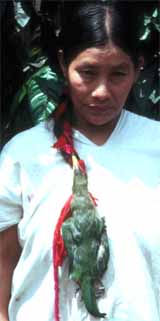 Lacandon woman wearing bird hair ornament |
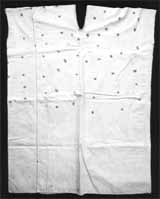 Tunic |
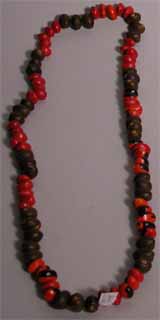 Seed necklaces |
Tunics are made of either softened bark cloth or cotton. Tunics were undecorated unless they were used in religious ceremonies in which they were painted with a red dye. Women also wore colorful skirts, ribbons, feathers, and seed necklaces. Married women wore the bird hair ornament. The seed necklaces were often painted or had coins or animal teeth and claws incorporated into them. The necklaces have also become one of the most popular tourist items (Palka 2005:48-51, 214).
Utilitarian objects
Utilitarian objects were used for domestic activities, farming, hunting and trade. This group consists of baskets, bow and arrow sets, stone and bone tools, deerskin leather bags, fiber nets, a wooden stool, cigars and raw tobacco. In addition, there are also items used for play and decoration such as ceramic dolls and figurines, and achiote pigment and paintbrushes.

Stone tools
Although metal tools such as machetes are utilized to a great extent, the Lacandon did not abandon their stone tool technologies. Metal degrades quickly in the tropical forest and so stone tools remain important. High quality chert is available in the lowlands and some of the most common items made are arrow points and stone grinders. The Lacandon would manufacture their stone tools in the god houses, incorporating religious songs into the process (Palka 2005:176-79, 205).
The wooden stool is a versatile domestic household item used in the preparation of food, such as making tortillas from ground corn.
 Wooden stool |
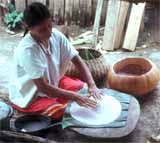 Lacandon woman using wooden stool |
Tobacco is grown and used by the Lacandon and was one of their most important trade items during colonial times. Once harvested, they let it dry inside houses until it was ready to be hand rolled into cigars.
 Rolled cigars |
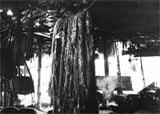 Drying tobacco |
Bows and arrows were used for hunting. Long bows were made from the wood of a chicle tree and bow strings from the braided fibers of the agave plant. Arrows were made of straight sticks or hollow reeds and stone points. There were several different types of arrow points; small arrows with a wide arrow head were used for a variety of birds and other small animals, and arrows with serrated prongs were used for hunting monkeys and other large animals. Bows and arrows have also become one of the biggest selling tourist items. In response to this, the Lacandon have started manufacturing miniature sets of bow and arrows that are easier for transport (Palka 2005:229; McGee 2002:87-91).
 Arrow points |
 Bow and arrow set |
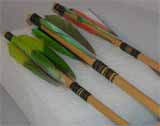 Feathers on arrows |
Ritual objects
A variety of objects were used in Lacandon religious ceremonies. This group of items includes ceramic god pots, copal incense, a flute, a conch shell trumpet, rattles, wooden boards for holding incense, and wooden spoons for making balché.
The god pot is a ceramic vessel used to burn the copal incense and was the most important ceremonial item used by the Lacandon. It was through these pots that the Lacandon communicated with the gods. God pots were made in a variety of shapes and sizes from clay fired in the open and then painted white with lime from snail shells. They were also decorated with red and black paint made from hematite and annatto dye and soot. Each face on a god pot represented a specific god. Straight hair and vertical stripes represented male deities while a crisscross design and braided hair indicated a female deity. Today, god pots are sold as tourist items but they are not as elaborately painted nor are they consecrated as sacred objects (Palka 2005:251-53).
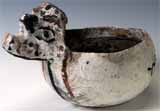 God pot |
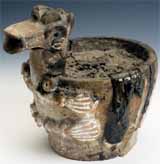 God pot |
The Lacandon used a variety of musical instruments in religious ceremonies such as drums, flutes, gourd rattles and conch shell trumpets. The conch shell trumpet, which was obtained through trade, was blown in the four cardinal directions, summoning both the gods and the people to the god house for the start of a ceremony (Palka 2005:204, 255; Thornquist 2006: pers. comm.).
 Rattle |
 Conch shell trumpet |
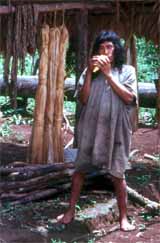 Lacandon Indian using conch shell trumpet |
Gourd containers were a common item used for storing, preparing and serving food, and in religious ceremonies for drinking balché, a mildly alcoholic drink thought to be both physically and spiritually purifying. The gourds were from locally-grown plants and were usually carved with various types of lines, symbols, geometric shapes, and human figures (Palka 2005:199-200).

Incised gourds

